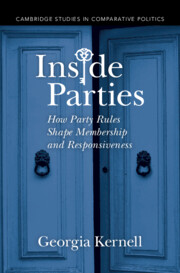6 - Party Responsiveness
Published online by Cambridge University Press: 25 February 2025
Summary
Chapter 6 shifts the focus from individual voter behavior to party responsiveness. Where decentralized rules foster internal competition, parties should select candidates and adopt positions that are more responsive to their core supporters and less responsive to the general electorate. To test these spatial hypotheses, Kernell employs computational simulations to identify vote-maximizing positions in the electorate and finds that decentralized parties adopt less competitive positions than their centralized competitors. All else equal, the electoral advantage for a party whose leaders select candidates over one whose members play a decisive role is close to 7 percent.
Keywords
- Type
- Chapter
- Information
- Inside PartiesHow Party Rules Shape Membership and Responsiveness, pp. 148 - 168Publisher: Cambridge University PressPrint publication year: 2025

